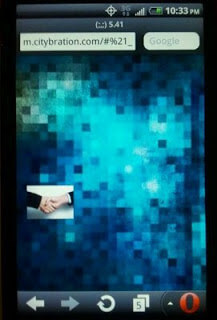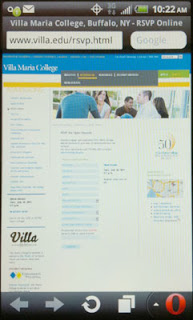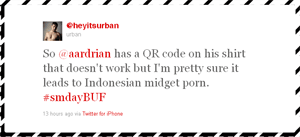Find QR Code Mistakes Before Making Your Own

The local AAF chapter here in Buffalo, Advertising Club of Buffalo, presented a primer on social media in its monthly AdLab event a couple nights ago. At the request of members, QR codes made an appearance on the topic list at the end of the presentation. While I could discuss the curious association QR codes seem to have with social media, that’s outside the scope of what I want to discuss.
Technology issues aside, the presenters tried to explain to attendees that QR codes themselves are a call to action, and just as any call to action you have to be prepared to support it. One audience member suggested that just sending someone to a web site was a bad idea, another tweeted that they should be ignored:
In general, I think the crowd missed the point. And I think that’s ok. If they don’t immediately see the value of a QR code then they probably haven’t identified a business case where it applies. I haven’t identified a business case for a blimp for my business, so I can pretty much forget about blimps. I think we can all agree that’s a safe way for me to go.
I have written about uses for QR codes before, but after my experience on Tuesday I am taking a different approach and writing up some practical, real-life experiences of where they fail in the hopes that I can provide some cautions when a real business case for their use does present itself.
Most people who will use a QR code will be using a smartphone. You don’t see too many people wrangle their netbook or laptop out of the case just to capture a QR code in a print ad at their local coffee shop. Some might even have their tablet computer (ok, iPad) handy and will use that instead (ok, iPad 2).
Mobile Unfriendly
This ad promotes a series of local events that spanned a few days over assorted venues. As a smartphone user, I was looking forward to the prospect of maps, timelines, and descriptions of all the events, though I really only expected the same web site I could view on my desktop computer.

But this is what I saw on my phone:
And this what I saw on an iPad (I am showing the contact page to demonstrate that it is definitely not the correct site):
For context, here is the site as it appears in my Flash-enabled desktop computer (note, no handshake stock image):

I reached out to the organization to tell them there were problems, and they were quick to address as best they could, but they were also limited by the platform they chose. They used a platform called Wix, which allows clients to make Flash-based web sites for free, and automatically shunts users to an HTML-powered mobile template if it senses the user is on a smartphone. The problem is that for non-technical clients, it is not clear that there is a mobile site nor is it clear how to maintain it. This is a classic example of You Get What You Pay For.
Not Mobile Optimized
The same newspaper where I found the QR code I discuss above had another advertisement for a local college promoting its open house. The text below the QR code directs readers to scan the code to RSVP for the open house.

This is what I saw on my smartphone:
Here’s what they did right with this: in the absence of being able to make a mobile-friendly site, they did nothing at all. It’s not a Flash-based site, and it’s not so reliant on cutting edge technology that a smartphone cannot render it. In fact, mobile browsers can handle this page pretty well.
Here’s what’s wrong: the user, having come to this page on his or her phone, now has to fill out 12 fields, including a simple spam blocker, to RSVP for the event. As an end user who just loaded the page on the phone to RSVP as the ad suggests, I didn’t expect I’d have to bloody my thumbs entering this much information (hyperbole anyone?). As a technical user, I was hoping for an easy way to add this event to my calendar and maybe directions to the college that aren’t a PDF download.
Context (added July 1, 2011)
In this example, I proudly wore my QR-code-embroidered shirt (well, one of them from my growing collection) to the Social Media Day event last night. Throughout the evening people asked about it and a few even scanned it — successfully.
As the night wore on and the bar became darker, there just wasn’t enough light to get good enough contrast for a QR code scanner. Once that happened, people asked what it linked to and one, as evidenced by the tweet above, even made his own assumption.
Knowing how people will scan your QR code comes from understanding where they will be when scanning (a water park, the office, a car) and what they will be doing (drowning, working, driving). It’s fair to assume that not all scenarios will be a good fit for a QR code, including some obvious ones like billboards on highways, so make an effort to understand the context of where it will appear along with the value of the reward for making the user go to the trouble.
Wrap-up
These are examples of good intentions. However, lack of a solid business case leading up to putting the QR code into advertisements, compounded by lack of understanding the medium after the QR code is scanned can result in a negative experience. Pile on the clear lack of testing on mobile devices for the first one and you have a recipe for disaster.
Now, to connect this with social media (because that’s where I am borrowing these rules and where this discussion started), if you don’t understand the medium, don’t have a business case, and aren’t prepared to commit (whether by testing or engaging) then that tweet way above is spot on — forget about QR codes.
Related
- How To Use QR Codes: A Marketer’s Guide
- 5 Qr Code Failures To Learn From, May 14, 2011.
- Making and Using QR Codes, March 28, 2011.
- Real World Hyperlinks, March 8, 2010.
One Comment
[…] previously written about QR codes that take users to mobile-unfriendly sites. That was 2011 and thankfully more and more sites are at least becoming responsive by default, but […]





Leave a Reply to QR Codes Work, Just Not in the U.S. | Adrian Roselli Cancel response